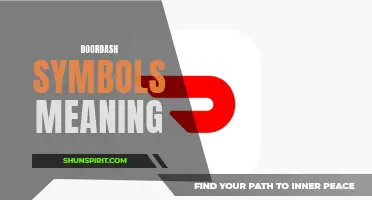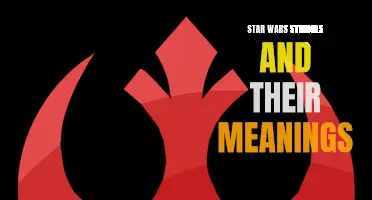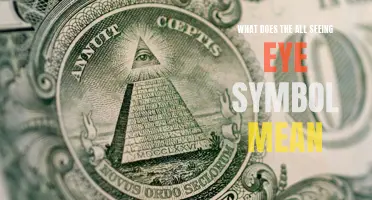
Traffic signs and symbols are the unsung heroes of our roads, silently guiding us through the chaos of traffic. These seemingly ordinary markers play a crucial role in keeping us safe, informing us of potential hazards, and giving us essential information about our surroundings. From the familiar red octagon of a stop sign to the winding arrow of a sharp curve, each sign has a specific meaning designed to communicate important messages to drivers. Understanding these signs is not only a legal requirement but also a matter of personal safety. So let's delve into the fascinating world of traffic signs and symbols and uncover the hidden meaning behind these symbols that help us navigate our daily journeys.
What You'll Learn
- What are the most common traffic signs and symbols on the roads?
- What is the meaning of the red octagon-shaped traffic sign?
- Are there any traffic signs specific to pedestrian crossings?
- How do different countries vary in their traffic sign and symbol designs?
- Are there any new or upcoming traffic signs and symbols that we should be aware of?

What are the most common traffic signs and symbols on the roads?
Traffic signs and symbols are an essential part of road safety. They communicate important information to drivers about the rules of the road and potential hazards ahead. Understanding these signs and symbols is crucial for every driver. In this article, we will discuss some of the most common traffic signs and symbols that you are likely to encounter on the roads.
- Stop Sign: The stop sign is a red octagon with the word "STOP" printed in white. It indicates that drivers must come to a complete stop before proceeding.
- Yield Sign: The yield sign is a red and white triangle with the word "YIELD" printed in white. It is used to indicate that drivers must give the right-of-way to other vehicles before proceeding.
- Speed Limit Sign: Speed limit signs indicate the maximum legal speed at which drivers can travel on a particular road. They are usually white and rectangular in shape, with black lettering indicating the specific speed limit.
- No Entry Sign: The no entry sign is a red circle with a white horizontal line inside. It is used to indicate that entry into a particular road or area is prohibited.
- One Way Sign: The one-way sign is a white rectangle with an arrow pointing in one direction. It indicates that traffic is allowed to flow in only one direction on a particular road.
- No U-Turn Sign: The no U-turn sign is a red circle with a white horizontal line inside, and a U-turn arrow crossed out in red. It is used to indicate that U-turns are not allowed in a particular area.
- Pedestrian Crossing Sign: The pedestrian crossing sign is a yellow diamond shape with a symbol of a person walking. It indicates that there is a designated area for pedestrians to cross the road.
- School Zone Sign: The school zone sign is a yellow pentagon shape with a symbol of a schoolhouse. It is used to indicate that drivers should exercise caution and reduce their speed in the vicinity of a school.
- Animal Crossing Sign: The animal crossing sign is a yellow diamond shape with a symbol of an animal. It is used to indicate that there is a likelihood of animals crossing the road in the area.
- No Parking Sign: The no parking sign is a red circle with a white horizontal line inside and the word "PARKING" crossed out in red. It indicates that parking is prohibited in a particular area.
These are just a few examples of the most common traffic signs and symbols that you are likely to encounter on the roads. It is important to familiarize yourself with these signs and symbols and to always obey them. By doing so, you can contribute to a safer and more efficient road system for everyone.
The Symbolic Meanings and Origins of the Claddagh Symbol
You may want to see also

What is the meaning of the red octagon-shaped traffic sign?
The red octagon-shaped traffic sign is one of the most recognizable symbols on the road. It is commonly used to indicate the presence of a stop sign. The meaning of this sign is simple yet important - it instructs drivers to come to a complete stop and yield the right of way to other vehicles and pedestrians.
Stop signs are installed at intersections to regulate traffic flow and prevent accidents. When drivers approach a stop sign, they must bring their vehicle to a complete stop before proceeding. This means that they should slow down, look for oncoming traffic, and only move forward when it is safe to do so. Failing to stop at a stop sign can result in traffic violations and fines, and even worse, it can lead to accidents causing injuries or even fatalities.
The red color of the sign is used to draw attention and convey a sense of urgency. It is a universal color for stop signals and is easily visible even from a distance. The octagonal shape is also distinctive and helps distinguish a stop sign from other types of traffic signs. The shape was chosen because it stands out among other signs, making it easily recognizable and helping drivers to quickly identify it.
The importance of following the instructions of a stop sign cannot be overstated. It is crucial for drivers to obey this sign to ensure the safety of themselves, other drivers, and pedestrians. When approaching a stop sign, it is important to be aware of your surroundings and be prepared to stop if necessary. Always keep an eye out for other vehicles and pedestrians, and be ready to yield the right of way if required.
In addition to obeying the stop sign, it is also important to be cautious when proceeding after stopping. Look in all directions and make sure there are no other vehicles approaching the intersection before you proceed. It's also a good practice to make eye contact with pedestrians to ensure they are aware of your presence and are not crossing in front of your vehicle.
Remember that stop signs are put in place for a reason - to prevent accidents and promote safety on the road. By adhering to the meaning of the red octagon-shaped traffic sign, you can play your part in maintaining order and minimizing the risks associated with traffic intersections. So the next time you encounter a stop sign, remember to come to a complete stop, yield the right of way, and proceed with caution.
The Symbolic Meaning Behind the Chair: Exploring its Significance
You may want to see also

Are there any traffic signs specific to pedestrian crossings?
When it comes to pedestrian crossings, there are several traffic signs that motorists should be aware of. These signs are designed to ensure the safety of pedestrians and guide drivers on the appropriate actions to take when approaching or crossing a pedestrian crossing. Here are some of the traffic signs specific to pedestrian crossings:
- Pedestrian Crossing Sign: This sign features a symbol of a person walking and is used to alert drivers that there is a pedestrian crossing ahead. It serves as a warning for drivers to be prepared to stop and yield the right-of-way to pedestrians who are crossing the road.
- Pedestrian Crossing Ahead Sign: This sign indicates that there is a pedestrian crossing approaching. It is often placed in advance of the crossing to provide motorists with sufficient time to slow down and be aware of pedestrians crossing the road.
- Yield to Pedestrians Sign: This sign is typically placed at pedestrian crossings to remind drivers to yield the right-of-way to pedestrians who are crossing the road. It serves as a reminder that drivers should slow down, stop if necessary, and allow pedestrians to safely cross the road before proceeding.
- School Crossing Sign: School crossings are areas where children cross the road either on their way to or from school. To alert drivers of these designated zones, school crossing signs are posted. These signs often display a symbol of a school child with a backpack, indicating that drivers should exercise caution and be prepared to stop for children crossing the road.
- Pedestrian Crossing Markings: In addition to traffic signs, there are also specific road markings that indicate the presence of pedestrian crossings. These markings typically consist of painted lines on the road, often in the shape of zebra crossings. The purpose of these markings is to visually guide pedestrians and drivers on where they should cross and where vehicles should yield to pedestrians.
It is important for motorists to be aware of these traffic signs and markings to ensure the safety of pedestrians. Adhering to these signs helps create a safer environment for both drivers and pedestrians, reducing the risk of accidents and injuries at pedestrian crossings. Remember to always be vigilant, obey traffic signs, and yield the right-of-way to pedestrians when approaching a designated pedestrian crossing.
Understanding Navionics Chart Symbols and Meanings
You may want to see also

How do different countries vary in their traffic sign and symbol designs?
Traffic signs and symbols are an essential part of road safety around the world. While their purpose is universal – to provide clear and concise information to drivers and pedestrians – the designs of these signs can vary significantly from one country to another. These variations often reflect the unique cultural, historical, and geographical aspects of each nation.
It is fascinating to explore the differences in traffic sign designs across different countries. For instance, one notable example is the roundabout sign. In many countries such as the United Kingdom, Australia, and New Zealand, roundabout signs are represented by a simple white circle with arrows indicating the direction of traffic flow. In contrast, some European countries such as France and Germany use a blue circular sign with small white arrows. These differences in design might seem minor, but they can provide valuable insights into the varying approaches to traffic management and infrastructure.
Another interesting variation lies in the depiction of pedestrian crossings. In the United States, pedestrian crossing signs typically feature a person walking, accompanied by flashing lights to alert drivers. On the other hand, in countries like the United Kingdom and Australia, these signs commonly depict a zebra-like pattern on the road surface, known as a zebra crossing. This difference highlights the emphasis on pedestrian safety and the different strategies employed to achieve it.
One particularly striking difference can be seen in the design of warning signs. In the United States, warning signs often use bold yellow or orange colors, accompanied by eye-catching symbols such as deer or curves. This approach aims to quickly draw attention to potential hazards on the road. Conversely, in Japan, warning signs tend to be more minimalist, featuring simple black symbols on a white background. This design embodies the Japanese principle of minimalism and highlights the country's focus on simplicity in everyday life.
Cultural and historical factors also play a role in the design of traffic signs and symbols. In Egypt, for example, the shape and style of road signs often incorporate elements of ancient Egyptian hieroglyphs, reflecting the country's rich historical heritage. Similarly, in China, the color red is often used on road signs to symbolize good luck and happiness, which are important cultural concepts in Chinese society.
In addition to cultural and historical influences, geographical factors can also impact the design of traffic signs. In regions prone to heavy snowfall, such as Scandinavia and Canada, road signs may feature a distinctive blue and white color scheme to ensure visibility in snowy conditions. These signs often incorporate reflective materials to increase visibility at night as well.
Overall, the variations in traffic sign designs across different countries offer a fascinating glimpse into the cultural, historical, and geographical influences on road safety. While the purpose of these signs remains constant – to provide clear and concise information – the unique characteristics of each nation are reflected in the designs. Understanding these variations can help promote a greater appreciation for different cultures and a deeper understanding of the importance of road safety worldwide.
The Intriguing Meaning Behind the Eye of Ra Symbol
You may want to see also

Are there any new or upcoming traffic signs and symbols that we should be aware of?
Traffic signs and symbols play a crucial role in ensuring road safety and guiding motorists on the roads. Over the years, traffic signs and symbols have continued to evolve to keep up with changing road conditions, technology, and the needs of road users. In recent years, there have been some new and upcoming traffic signs and symbols that we should be aware of. Let's take a look at some of them.
One of the new traffic signs that have been introduced is the "No texting while driving" sign. With the rise of smartphones and the increased use of technology in our daily lives, distracted driving has become a significant issue on the roads. This sign is a reminder to drivers to avoid using their phones while behind the wheel and pay attention to the road.
Another new sign that has been introduced is the "Bicycle Lane Ahead" sign. As more people are opting for cycling as a mode of transportation, bicycle lanes have become more common in many cities and towns. This sign alerts drivers to the presence of a bicycle lane ahead and reminds them to be aware of cyclists on the road.
In addition to new signs, there have also been some changes to existing signs. For example, the "Yield" sign has been modified to include additional symbols. The new sign features a yield symbol along with a pedestrian symbol, reminding drivers to yield to pedestrians at intersections and crosswalks. This change aims to improve pedestrian safety and encourage drivers to be more cautious.
Furthermore, advancements in technology have led to the development of new traffic symbols. One such symbol is the "Connected Vehicle" symbol. Connected vehicles are equipped with technology that allows them to communicate with each other and with infrastructure, such as traffic signals. The symbol indicates the presence of these connected vehicles on the road and serves as a reminder to drivers to be aware of their presence and act accordingly.
As traffic conditions continue to change and new technologies emerge, it is essential to stay informed about new and upcoming traffic signs and symbols. Being aware of these signs and symbols can help us navigate the roads safely and reduce the risk of accidents. It is also crucial for drivers to understand the meaning of these signs and symbols and follow them diligently.
To stay updated on new and upcoming traffic signs and symbols, it is recommended to regularly check with local transportation authorities or visit official websites that provide information on road safety and regulations. Additionally, drivers can take advantage of driver education programs that offer information on traffic signs and symbols, ensuring they are well-informed and equipped to drive safely.
In conclusion, there have been some new and upcoming traffic signs and symbols that we should be aware of. These signs and symbols reflect changes in road conditions, advancements in technology, and the need to improve road safety. By staying informed about these signs and symbols, we can contribute to creating a safer and more efficient road environment for everyone.
The Complete Guide to Cadillac Escalade Dashboard Symbols and Meanings
You may want to see also







